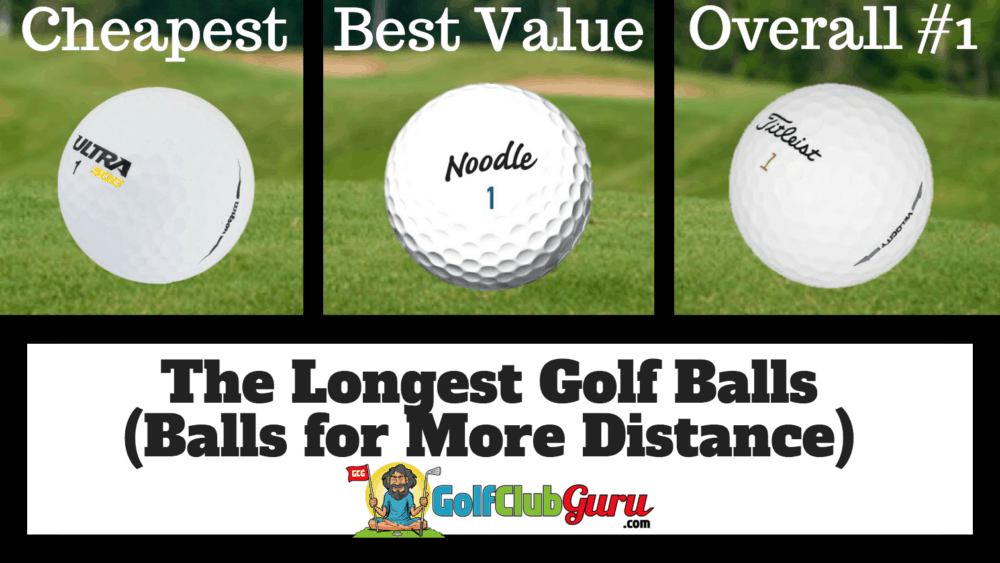What do you actually want in a golf ball? Feel? Spin? Distance control? Or distance?
If you chose distance, this article is for you. I’m not going to be talking about which ball spins the most around the greens. I won’t be talking about the ball that feels the best at impact, or the one that is the most durable, or the one that is best for workability, or the one that is the best for straighter drives. I will be talking about what golf balls flies the furthest… that’s it!
So if you are looking for the greatest overall golf ball, you came to the wrong place. But if you want the LONGEST golf ball that you can buy, depending on your budget of course, then keep reading.
First, let’s talk about how each aspect of the design of a golf ball is going to maximize distance. I’ll do a short version for those like myself that hate reading. Then, I’ll do a long version for you nerds that like actually knowing why things happen (nerds!!!).
What makes a golf ball longer than the rest? What makes a golf ball best for distance? Great questions!
Short Version:
- Cheaper: compared to premium golf balls that focus on spin and control, distance golf balls are much cheaper
- Harder feel: the harder the ball (when it comes to feel and materials) the longer it will fly
- Piece/Layer Construction: Two piece golf balls (just an outside layer and a large core) are the best for distance
- Cover (Outside Layer) Material: Surlyn covers are harder and longer than Urethane covers
- Compression: Higher compression golf balls are longest for higher swing speeds. Lower compression golf balls are longest for slower swing speeds.
Long Version:
- Cheaper: premium golf balls are multilayered and composed of higher quality, more expensive materials. As a result, those premium balls come at… well, a premium. Distance balls require less R&D, less expensive materials, and less layers, so they are cheaper.
- Harder: the harder the ball, the longer it is going to be. Softer balls are better for feel and workability. A simple test would be to drop (don’t throw) a couple of balls on the ground from the same height and see which one bounces back the heighest. The harder the ball is, the further it will bounce back. The same thing is going to happen in the golf swing, expect instead of hitting the ground, the balls are going to be hit by your club head.
- Two piece ball: this is very similar to the point above. The more “pieces” (layers inside the outer surface of the golf ball) a golf ball has, the softer it will be and the less distance it is going to be. The best distance balls are 2 piece balls typically, meaning they are made up of only the golf ball cover and the core. Note that the 3+ piece balls are still good for distance, but not as long as a 2 piece ball on average
- Dimple pattern: all golf balls have different dimple patterns. The most notable or distinguishable ones are Bridgestone’s and Callaway’s dimple patterns. The whole reason for dimples is to make the golf ball go further, so you better believe ball manufacturers design their dimples to best improve the ball’s flight and distance. Varying shapes, sizes and patterns all affect the distance that a golf ball will travel.
- Outer coating/surface: There are two main types of golf ball covers: Surlyn and urethane. Surlyn are more durable and spin less than Urethane covers, which are typically found on premium golf balls.
- Compression: Higher compression balls are made for faster swing speed golfers. A golf ball briefly deforms once hit at impact, and you need to reach the core to get the most distance possible. Golfers with slow swing speeds that want the most distance need to use a lower compression golf ball to maximize the deformation effect created at impact. Manufacturers rarely advertise the compression rating, preferring to categorise through feel. However, the range is typically from 40 to 100. To be honest, they are not always accurate, as many “100 compression” balls have been found to truly be closer to 80. I’m going to support the ideas of Titleist, who says that compression really doesn’t matter that much.
Alright let’s get into the good stuff. Here are the best golf balls that you can buy, depending on both your club head speed and your budget.
The Cheap, Long Golf Ball: Wilson Ultra 500 Distance
If you want the cheapest option golf ball that is focused on distance, then check out the Wilson Ultra 500 Distance golf balls. They are priced much lower than the other options, so they are perfect for those on a tight budget that can’t spend much on golf balls.
Wilson always comes in clutch for cheap, decent quality golf equipment, and golf balls are no exception. These balls will fly far, but they don’t do much more than that. They do come in two colors at least. This ball is hard as anything, so don’t expect a great feel or any sort of spin around the greens. However, that’s a good thing that this ball is low spin, because that means less slices and more straight drives are coming your way.
For a beginner just trying to hit the ball as far as possible, stick with this ball. Otherwise, I’d suggest spending a tad more and getting a better option.
Some benefits:
- can be personalized with three lines of text for a tad extra
- comes in a pack of 15 for super, super low price
- super durable cover
- high energy core (hard golf ball)
- surlyn cover, two piece construction
- the best cheap distance ball in my opinion
The Best Value Distance Ball on a Budget: Noodle Long & (not so) Soft
Noodle golf balls are a godsend in my opinion. The absolute perfect mix between price and distance. If you are like me and only want the “best value” options, Noodle golf ball are the ones for you. I know even better golfers that use this ball. It performs like a ball double its price, yet its focus is still on distance.
The ball flies far.. no doubt about it. It also performs better in every other category compared to the Wilson Ultra 500 Distance balls. So if you want to save money but don’t want a low quality golf ball, this is your best bet.
Although the distance control might not be perfect, I won’t believe you if you say there’s a better value distance golf ball on the market.
Why you might like it:
- best bang for your buck
- patented dimple design for straighter shots. Less curve -> more distance.
- very low spin rates
- super long for the price
- two piece design, surlyn cover
- best mix of price and distance
The #1 Distance Golf Ball: Titleist Velocity
Titleist, the best brand in golf balls, makes one golf ball that is focused solely on distance. It’s called the Titleist Velocity golf ball, and it’s the best of the best when you want to hit it the furthest. They are very upfront about this golf ball being intended to just fly as far as possible. That means it won’t spin on just about any shot that you hit. That’s great for slicers and hookers, as reduced spin will ease your mishits and make them less punishable.
I’ve played many rounds with Titleist Velocity golf balls, mostly when I was new to the game, and I can vouch that the distance is incredible. I feel like I hit a lot of knuckle balls with them, meaning they have very little spin and are hardly affected by the wind.
Considering how great this ball is when it comes to distance, I was very pleased with how the ball felt at impact, which is rare for a distance golf ball.
Here’s why it’s the best:
- overall best golf ball for distance
- lowest spin rate of the ones listed in this article
- durable cover to make it longer lasting
- feels like its hardly affected by the wind
- two piece design with a surlyn cover
- super long, but also feels decent at impact
The Best Distance Golf Ball for Women: Bridgestone Lady Precept
Women need a slightly lower compression golf ball, unless you have far above average swing speed. For that reason, these Bridgestone Lady Precept golf balls are the longest, lowest compression golf balls that you can buy. For women with slower that average swing speeds, these are the ones for you.
Higher end golf balls require that you hit the ball hard enough to actually make the core react so that you get the most distance out of the ball. However, these balls don’t require fast speeds to get the most distance possible. There are similar balls that sell for much more due to better feel. These balls don’t excel when it comes to feel, but they excel when it comes to solely distance!
Benefits:
- available in three colors
- low compression to get the most out of slower swings
- hard outer layer and soft inner core
- dimple design to lessen backspin
- simple two layer construction
The Best Golf Ball for Distance for Seniors: Volvik DS-55
For seniors looking for the longest golf ball off the tee, the Volvik DS-55 golf balls are a great option. They come in bright, vibrant colors and have the lowest compression on the market without getting into women’s golf balls. So for those that don’t hit the ball as long as they wish, this ball is for them.
It’s also a huge benefit that they come in vibrant, easy-to-see colors. That makes them easy to stand out when searching for them, great for seniors that might not have the best eye sight anymore. These balls are designed for distance… nothing else. They have a very elastic core that should shoot the ball off the face at fast speeds and with little backspin.
Low compression + vibrant colors + hard outer layer = the perfect distance golf ball for senior.
Why seniors should buy it:
- available in three colors
- lowest compression golf ball that isn’t specifically for women
- hard outer cover
- two layer construction with surlyn cover










Good
Haha, because ball knows who is swinging the club, women or men.
Thank you for so much great information. I would love to know how much distance I have been losing off the tee with the premium golf balls I use!!
Hi! Would you mind if I share your blog with my facebook group? There’s a lot of folks that I think would really appreciate your content. Please let me know. Thanks